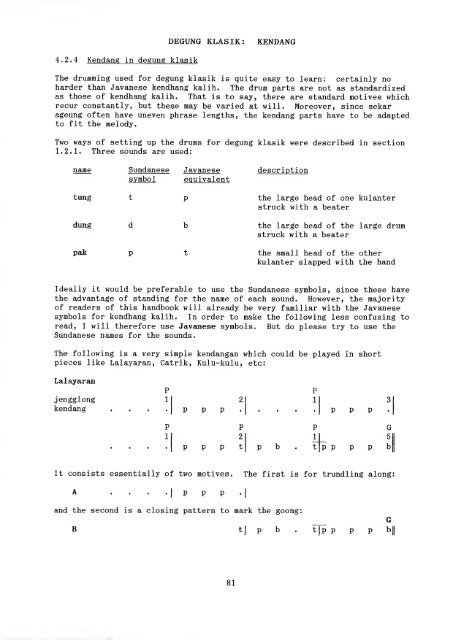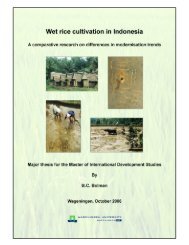Guide to Sundanese Music - Free EBooks Library
Guide to Sundanese Music - Free EBooks Library
Guide to Sundanese Music - Free EBooks Library
You also want an ePaper? Increase the reach of your titles
YUMPU automatically turns print PDFs into web optimized ePapers that Google loves.
4-2.4 Kendang in degung klasik<br />
DEGUNG KLASIK: KENDANG<br />
The drumming used for degung klasik is quite easy <strong>to</strong> learn: certainly no<br />
harder than Javanese kendhang kalih. The drum parts are not as standardized<br />
as those of kendhang kalih. That is <strong>to</strong> say, there are standard motives which<br />
recur constantly, but these may be varied at will. Moreover, since sekar<br />
ageung often have uneven phrase lengths, the kendang parts have <strong>to</strong> be adapted<br />
<strong>to</strong> fit the melody.<br />
Two ways of setting up the drums for degung klasik were described in section<br />
1.2.1. Three sounds are used:<br />
name<br />
tung<br />
dung<br />
pak<br />
<strong>Sundanese</strong> Javanese<br />
symbol equivalent<br />
t<br />
d<br />
P<br />
description<br />
the large head of one kulanter<br />
struck with a beater<br />
the large head of the large drum<br />
struck with a beater<br />
the small head of the other<br />
kulanter slapped with the hand<br />
Ideally it would be preferable <strong>to</strong> use the <strong>Sundanese</strong> symbols, since these have<br />
the advantage of standing for the name of each sound. However, the majority<br />
of readers of this handbook will already be very familiar with the Javanese<br />
symbols for kendhang kalih. In order <strong>to</strong> make the following less confusing <strong>to</strong><br />
read, I will therefore use Javanese symbols. But do please try <strong>to</strong> use the<br />
<strong>Sundanese</strong> names for the sounds.<br />
The following is a very simple kendangan which could be played in short<br />
pieces like Lalayaran, Catrik, Kulu-kulu, etc:<br />
Lalayaran<br />
jengglong<br />
kendang<br />
It consists essentially of two motives. The first is for trundling along:<br />
A • . . •<br />
I P P P .<br />
and the second is a closing pattern <strong>to</strong> mark the goong:<br />
B tl p b . tip p p p bll<br />
81<br />
I<br />
__<br />
P P<br />
G<br />
51<br />
b<br />
G








